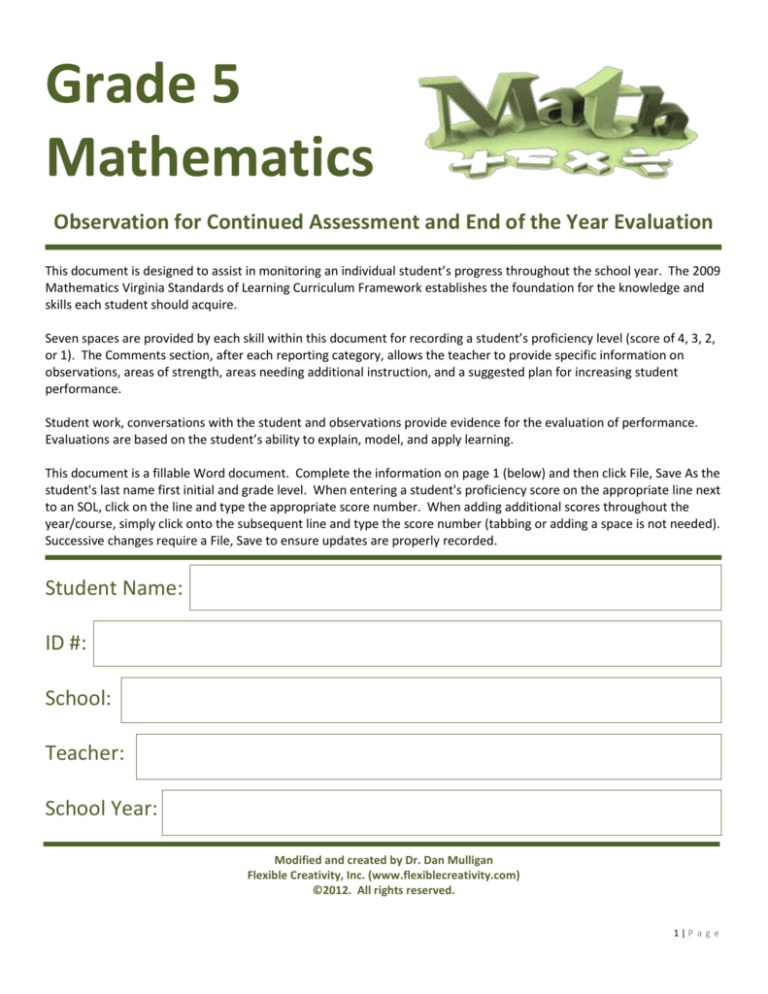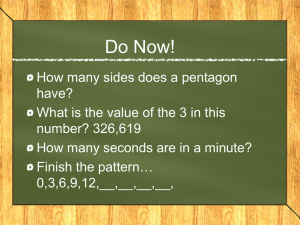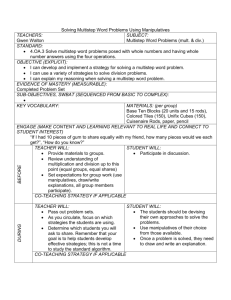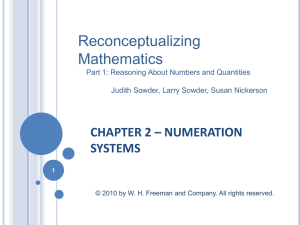
Grade 5
Mathematics
Observation for Continued Assessment and End of the Year Evaluation
This document is designed to assist in monitoring an individual student’s progress throughout the school year. The 2009
Mathematics Virginia Standards of Learning Curriculum Framework establishes the foundation for the knowledge and
skills each student should acquire.
Seven spaces are provided by each skill within this document for recording a student’s proficiency level (score of 4, 3, 2,
or 1). The Comments section, after each reporting category, allows the teacher to provide specific information on
observations, areas of strength, areas needing additional instruction, and a suggested plan for increasing student
performance.
Student work, conversations with the student and observations provide evidence for the evaluation of performance.
Evaluations are based on the student’s ability to explain, model, and apply learning.
This document is a fillable Word document. Complete the information on page 1 (below) and then click File, Save As the
student's last name first initial and grade level. When entering a student's proficiency score on the appropriate line next
to an SOL, click on the line and type the appropriate score number. When adding additional scores throughout the
year/course, simply click onto the subsequent line and type the score number (tabbing or adding a space is not needed).
Successive changes require a File, Save to ensure updates are properly recorded.
Student Name:
ID #:
School:
Teacher:
School Year:
Modified and created by Dr. Dan Mulligan
Flexible Creativity, Inc. (www.flexiblecreativity.com)
©2012. All rights reserved.
1|P a g e
Scoring Rubric - Proficiency Levels
Exceeds Expected Proficiency (4)
consistent performance beyond grade level
works independently; shows confidence and initiative
understands advanced concepts
applies strategies creatively
analyzes and synthesizes
justifies and elaborates responses
makes critical judgments
makes application and extensions beyond grade level; exceeds Proficient
competencies in more challenging situations
Proficient (3)
exhibits consistent performance
shows conceptual understanding
applies strategies in most situations
responds with appropriate answer or procedure
completes task accurately; needs minimal assistance
exhibits fluency and applies learning
shows some flexibility in thinking
works in confidence
recognizes cause and effect relationships; applies models, and explains
concepts
Not Yet Proficient (2)
exhibits inconsistent performance and misunderstandings at times
shows some evidence of conceptual understanding
has difficulty applying strategies or completing tasks in unfamiliar
situations
responds with appropriate answer or procedure sometimes
requires teacher guidance frequently
needs additional time, opportunities
demonstrates some proficient competencies but is inconsistent
Limited Proficiency (1)
exhibits minimal performance
shows very limited evidence of conceptual understanding and use of
strategies
responds with inappropriate answer and/or procedure frequently
very often displays misunderstandings
completes task appropriately and accurately infrequently
needs assistance, guidance and modified instruction
2|P a g e
Number and Number Sense
5.1 Overall Score
a. Round decimal numbers to the nearest whole number, tenth or
hundredth
5.2 Overall Score
a. Represent fractions (halves, fourths, fifths, eighths, tenths, and
twelfths) in their equivalent decimal form and vice versa
b. Recognize and name equivalent relationships between decimals and
fractions with denominators up to 12
c. Compare and order from least to greatest and greatest to least a
given set of no more than five numbers written as decimals,
fractions, and mixed numbers with denominators of 12 or less
5.3 Overall Score
a. Identify prime numbers less than or equal to 100
b. Identify composite numbers less than or equal to 100
c. Explain orally and in writing why a number is prime or composite
d. Identify which numbers are even or odd
e. Explain and demonstrate with manipulatives, pictorial
representations, oral language, or written language why a number is
even or odd
Comments
3|P a g e
Computation and Estimation
5.4 Overall Score
a. Select appropriate methods and tools from among paper and pencil,
estimation, mental computation, and calculators according to the
context and nature of the computation in order to compute with
whole numbers
b. Create single-step and multistep problems involving the operations
of addition, subtraction, multiplication, and division with and
without remainders of whole numbers, using practical situations
c. Estimate the sum, difference, product, and quotient of whole
number computations
d. Solve single-step and multistep problems involving addition,
subtraction, multiplication, and division with and without
remainders of whole numbers, using paper and pencil, mental
computation, and calculators in which
1. sums, differences, and products will not exceed five digits
2. multipliers will not exceed two digits
3. divisors will not exceed two digits
4. dividends will not exceed four digits
e. Use two or more operational steps to solve a multistep problem.
Operations can be the same or different
5.5 Overall Score
a. Determine an appropriate method of calculation to find the sum,
difference, product and quotient of two numbers expressed as
decimals through thousandths, selecting from among paper and
pencil, estimation, mental computation, and calculators
b. Estimate to find the number that is closest to the sum, difference,
and product of two numbers expressed as decimals through
thousandths
c. Find the sum, difference, and product of two numbers expressed as
decimals through thousandths, using paper and pencil, estimation,
mental computation, and calculators
d. Determine the quotient, given a dividend expressed as a decimal
through thousandths and a single-digit divisor. For example, 5.4
divided by 2 and 2.4 divided by 5
e. Use estimation to check the reasonableness of a sum, difference,
product, and quotient
f. Create and solve single-step and multistep problems
g. A multistep problem needs to incorporate two or more operational
steps (operations can be the same or different)
4|P a g e
5.6 Overall Score
a. Solve single-step and multistep practical problems involving addition
and subtraction with fractions having like and unlike denominators.
1
Denominators in the problems should be limited to 12 or less (e.g., 5
1
+ 4), and answers should be expressed in simplest form
b. Solve single-step and multistep practical problems involving addition
and subtraction with mixed numbers having like and unlike
denominators, with and without regrouping. Denominators should
be limited to 12 or less, and answers should be expressed in simplest
form
c. Use estimation to check the reasonableness of a sum or difference
5.7 Overall Score
a. Simplify expressions by using the order of operations in a
demonstrated step-by-step approach
b. Find the value of numerical expressions, using the order of
operations
c. Given an expression involving more than one operation, describe
which operation is completed first, which is second, etc.
5|P a g e
Comments
6|P a g e
Measurement
5.8 Overall Score
a. Determine the perimeter of a polygon, with or without diagrams,
when
1. the lengths of all sides of a polygon that is not a rectangle or a
square are given
2. the length and width of a rectangle are given
3. the length of a side of a square is given
b. Estimate and determine the perimeter of a polygon, and area of a
square, rectangle, and right triangle following the parameters listed
above, using only whole number measurements given in metric or
U.S. Customary units, and record the solution with the appropriate
unit of measure (e.g., 24 square inches)
c. Estimate and determine the area of a square, with or without
diagrams, when the length of a side is given
d. Estimate and determine the area of a rectangle, with or without
diagrams, when the length and width are given
e. Estimate and determine the area of a right triangle, with or without
diagrams, when the base and the height are given
f. Differentiate among the concepts of area, perimeter, and volume
g. Develop a procedure for finding the volume using manipulatives
(e.g., cubes)
h. Determine volume in standard units
i. Describe practical situations where area, perimeter, and volume are
appropriate measures to use, and justify their choices orally or in
writing
j. Identify whether the application of the concept of perimeter, area,
or volume is appropriate for a given situation
k. Identify equivalent measurements within the metric system for:
1. length: millimeters, centimeters, meters, and kilometers
2. weight: grams and kilograms
3. liquid volume: milliliters and liters
l. Solve problems involving measurement by selecting an appropriate
measuring device and a U.S. Customary or metric unit of measure
for the following:
1 1 1
1. length: part of an inch (2, 4, 8), inches, feet, yards, millimeters,
centimeters, meters, and kilometers
2. weight: ounces, pounds, and tons
3. mass: grams and kilograms
4. liquid volume: cups, pints, quarts, gallons, milliliters, and liters
5. area: square units
6. temperature: Celsius and Fahrenheit units (water freezes at 0°C
and 32°F; boils at 100°C and 212°F; normal body temperature is
37°C and 98.6°F
7|P a g e
5.9 Overall Score
a. Identify and describe the diameter, radius, chord, and circumference
of a circle
b. Describe the relationship between
1. diameter and radius
2. diameter and chord
3. radius and circumference
4. diameter and circumference
c. The length of the diameter of a circle is twice the length of the
radius
5.10 Overall Score
a. Determine elapsed time in hours and minutes within a 24-hour
period
5.11 Overall Score
a. Identify the appropriate tools (e.g., protractor and straightedge or
angle ruler as well as available software) used to measure and draw
angles and triangles
b. Measure right, acute, straight, and obtuse angles, using appropriate
tools, and identify their measures in degrees
c. Recognize angle measure as additive. When an angle is decomposed
into nonoverlapping parts, the angle measure of the whole is the
sum of the angle measures of the parts
d. Solve addition and subtraction problems to find unknown angle
measures on a diagram in practical and mathematical problems,
(e.g., by using an equation with a symbol for the unknown angle
measure)
8|P a g e
Comments
9|P a g e
Geometry
5.12 Overall Score
a. Classify angles as right, acute, straight, or obtuse
b. Classify triangles as right, acute, or obtuse
c. Classify triangles as equilateral, scalene, or isosceles
5.13 Overall Score
a. Develop definitions for squares, rectangles, triangles,
parallelograms, rhombi, and trapezoids
b. Investigate and describe the results of combining and subdividing
plane figures
Comments
10 | P a g e
Probability and Statistics
5.14 Overall Score
a. Construct a sample space, using a tree diagram to identify all
possible outcomes of a single event
b. Construct a sample space, using a list or chart to represent all
possible outcomes of a single event
c. Predict and determine the probability of an outcome by constructing
a sample space. The sample space will have a total of 24 or less
possible outcomes
5.15 Overall Score
a. Formulate the question that will guide the data collection
b. Collect data, using observations (e.g., weather), measurement (e.g.,
shoe sizes), surveys (e.g., hours watching television), or experiments
(e.g., plant growth)
c. Organize the data into a chart, table, stem-and-leaf plots, and line
graphs
d. Display data in line graphs and stem-and-leaf plots
e. Construct line graphs, labeling the vertical axis with equal whole
number, decimal, or fractional increments and the horizontal axis
with continuous data commonly related to time (e.g., hours, days,
months, years, and age). Line graphs will have no more than six
identified points along a continuum for continuous data (e.g., the
decades: 1950s, 1960s, 1970s, 1980s, 1990s, and 2000s)
f. Construct a stem-and-leaf plot to organize and display data, where
the stem is listed in ascending order and the leaves are in ascending
order, with or without commas between leaves
g. Title the given graph or identify the title
h. Interpret the data in a variety of forms (e.g., orally or in written
form)
5.16 Overall Score
a. Describe and find the mean of a group of numbers representing data
from a given context as a measure of center
b. Describe and find the median of a group of numbers representing
data from a given context as a measure of center
c. Describe and find the mode of a group of numbers representing data
from a given context as a measure of center
d. Describe mean as fair share
e. Describe and find the range of a group of numbers representing data
from a given context as a measure of variation
f. Describe the impact on measures of center when a single value of a
data set is added, removed, or changed
11 | P a g e
Comments
12 | P a g e
Patterns, Functions, and Algebra
5.17 Overall Score
a. Describe numerical and geometric patterns formed by using
concrete materials and calculators
b. Describe the relationship found in patterns, using words, tables, and
symbols to express the relationship
5.18 Overall Score
a. Describe the concept of a variable (presented as boxes, letters, or
other symbols) as a representation of an unknown quantity
b. Write an open sentence with addition, subtraction, multiplication, or
division, using a variable to represent a missing number
c. Model one-step linear equations using a variety of concrete
materials such as colored chips on an equation mat or weights on a
balance scale
d. Create and write a word problem to match a given open sentence
with a single variable and one operation
5.19 Overall Score
a. Investigate and recognize the distributive property of whole
numbers, limited to multiplication over addition using diagrams and
manipulatives
b. Investigate and recognize an equation that represents the
distributive property, when given several whole number equations,
limited to multiplication over addition
13 | P a g e
Comments
14 | P a g e











